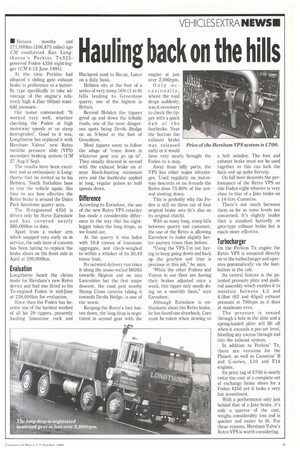Hauling back on the hills
Page 11

If you've noticed an error in this article please click here to report it so we can fix it.
• Sixteen months and 171,000km (106,875 miles) ago CM roadtested Ken Longthorne's Perkins Tx325powered Foden 4350 eight-legger (CM 642 June 1991).
At the time Perkins had adopted a sliding gate exhaust brake in preference to a butterfly type specifically to take advantage of the engine's relatively high 4.1bar (60psi) manifold pressure.
Our tester commented: "It worked very well, whether checking the Foden at high motorway speeds or on steep downgrades". Good as it was, Longthorne has replaced it with Hersham Valves' new Retro variable pressure slide (VPS) secondary braking system (CM 27 Aug-2 Sep).
The results have been excellent and so enthusiastic is Longthorne that he invited us to his Hebden, North Yorkshire base to test the vehicle again; this time to see how effective the Retro brake is around the Dales Park limestone quarry area.
The H-registered 4350 is driven only by Steve Earnshaw and has covered nearly 260,000km to date.
Apart from a rocker arm which snapped very early on in service, the only item of concern has been having to replace the brake shoes on the front axle in April at 200,000km.
Evaluation
Longthorne heard the claims made for Hersham's new Retro device and had one fitted to his Tx-engined Foden in mid-June at 238,000km for evaluation.
Since then the Foden has become one of the hardest worked of all his 29 tippers, presently hauling limestone rock and Blackpool sand to Bacup, Lancs on a daily basis.
Hebden sits at the foot of a series of very steep 16% (1-in-6) fells leading to Greenhow quarry, one of the highest in Britain.
Beyond Hebden the tippers grind up and down the fellside roads, one of the most dangerous spots being Devils Bridge on an S-bend at the foot of Greenhow.
Most tippers seem to follow the adage of "come down in whatever gear you go up in". They usually descend in second with the exhaust brake on at near block-busting maximum revs and the footbrake applied in long, regular pulses to hold speeds down.
Difference
According to Earnshaw, the use of the new Retro VPS retarder has made a considerable difference to the way that his eightlegger takes the long drops, as we found out.
At the quarry it was laden with 19.8 tonnes of limestone aggregate, and check-weighed to within a whisker of its 30.49 tonne limit.
Its outward delivery run takes it along the stone-walled B6265 towards Skipton and on into Lancashire but the first major descent, the road past nearby Stump Cross caverns taking it towards Devils Bridge, is one of the worst.
Keeping the Retro's foot button down, the long drop is negotiated in second gear with the engine al just over 2,000rpm.
Only occasionally, where the road drops suddenly, was it necessary to check the tipper with a quick dab of the footbrake, Near the bottom the exhaust brake was released early or it would have very nearly brought the Foden to a stop.
Away from hilly parts, the VPS has other major advantages. Used regularly on motorway descents or on A-roads the Retro does 75-80% of the normal slowing down.
This is probably why the Foden is still on three out of four original brake sets (it's also on its original clutch).
With so many long, steep hills between quarry and customer, the use of the Retro is allowing Earnshaw to make slightly better journey times than before.
"Using the VPS I'm not having to keep going down and back up the gearbox and time is precious in this job," he says.
"While the other Fodens and Volvos in our fleet are having their brakes adjusted once a week, this tipper only needs doing on a monthly basis," says Earnshaw.
Although Earnshaw is enthusiastic about the Retro brake, he has found one drawback. Care must be taken when slowing to
ttAitri(4 ra !io 1 '41 1—$
a halt unladen. The foot and exhaust brake must not be used together as this can lock the back end up quite fiercely.
On full bore descents the performance of the Retro VPS on this Foden eight-wheeler is very close to that of a Jake brake on a 14-litre Cummins.
There's not much between them as far as noise levels are concerned, It's slightly louder than a standard butterfly or gate-type exhaust brake but is much more effective.
Turbocharger
On the Perkins Tx engine the Retro VPS is mounted directly on to the turbocharger and operates pneumatically via the footbutton in the cab.
Its central feature is the patented pressure plate and pushrod assembly which enables it to maintain between 4.3 and 4.5bar (62 and 65psi) exhaust pressure at 700rpm as it does at maximum revs.
The pressure is sensed through a hole in the slide and a spring-loaded plate will lift off when it exceeds a pre-set level, bleeding any excess through and into the exhaust system.
In addition to Perkins' Tx, there are versions for the Phaser, as well as Cummins' B and C-series, L10 and E14 engines.
Its price tag of .Z700 is nearly twice the cost of a complete set of exchange brake shoes for a Foden 4350 yet it looks a very fair investment.
With a performance only just behind that of a Jake brake, it's only a quarter of the cost, weighs considerably less and is quicker and easier to fit. For these reasons, Hersham Valve's Retro VPS is worth considering.
















































































